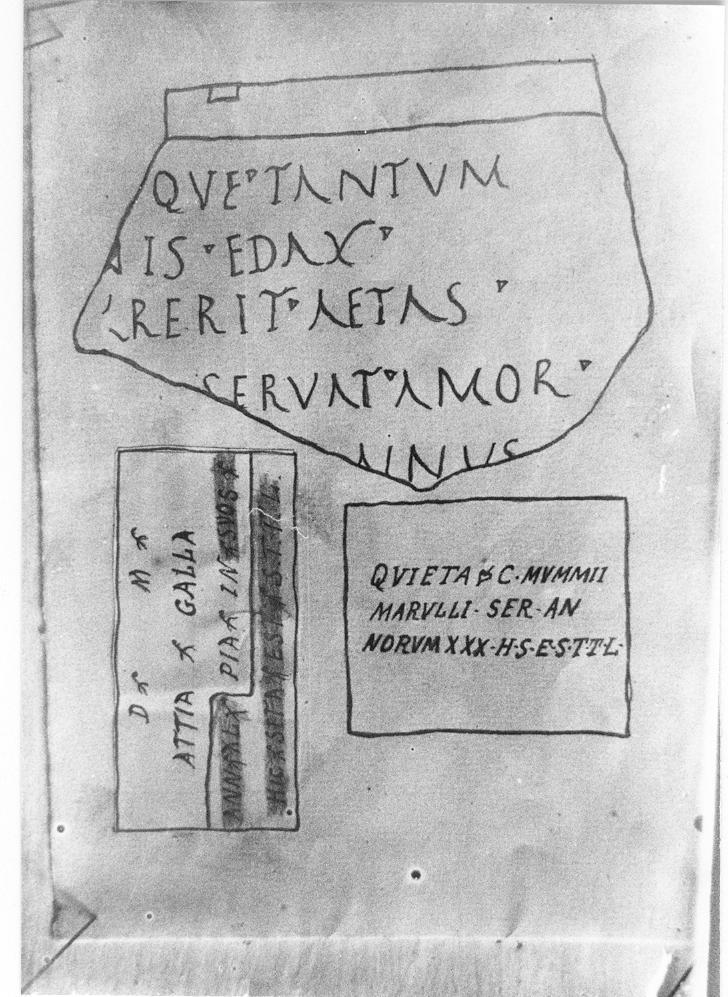(Español) AL2
Reference HEp 2003/04, 00008 | Description | Lyrics | Location | Chronology | Epigraphic edition | Translation | Apparatus | Comentary | Type of verse | Text divided into verses and metric signs | Images | Bibliography | Link to DB | Author |
Description
- Idno filename 22/01/0006
- Type of inscription: Sepulcralis
- Support: Placa
- Material: Mármol Material Description: White colour.
- Conservation status: A fragment of the top right-hand side is conserved, the original size of surviving letters being unknown.
- Dimensions height/width/depth (cm): 13/8/-
-
Epigraphic field:
- Layout: Hederae separated each word and the end of each verse, with the vertex pointing downwards.
Lyrics
- Font:Capital con tendencia a libraria
- Description of the letters:From the remains of the letters conserved it is clear that they tended towards cursive and were of unequal execution (<A>, <M>, <E>, <X>), with the upper oblong stroke of the <T>s particularly noticeable.
Location
- Place of discovery: From Adra, Abdera, owned and discovered by Leopoldo Segado Aquino, who drew it and had it photographed on 15 December 1916 by R. Raja Guerrero, from Berja (photograph published in FITA 1917). It was found on 15 December 1897 on the ridge of Montecristo, in the part which faces south, some 100 m to the north of the hermitage of St Sebastian, and was buried half a metre under the ground.
- Geolocation
- Location with Modern Nomenclature España / Almería / Adra
- Location with Old Nomenclature Hispania / Baetica / Gaditanus / Abdera
Chronology
- Inscription's dating: Between year 201 and year 299
- Dating explanation: 3rd c. AD from the paleography of the letters in the drawing.
Type of verse
- Type of verse: Dactílico (dístico elegíaco)
- Verse/line correspondence: Si
- Prose/verse distinction: No
Epigraphic edition
[‑ ‑ ‑]que ❦ tantum
[‑ ‑ ‑ig]nis edax ❦
[‑ ‑ ‑cucu]rrerit ❦ aetas ❦
[‑ ‑ ‑] servat ❦ amor ❦
5 [‑ ‑ ‑]m ❦ ⁽an⁾n(orum) LX s(it) t(ibi) [t(erra) l(evis)]
Text divided into verses and metric signs
[‑ ‑ ‑]que tantum [ln|ln|ln|ln|lk]k|l~
[‑ ‑ ‑ ig]nis edax [ln|ln|l||lkk|l]kk|~
[‑ ‑ ‑ cucu]rrerit aetas [ln|ln|ln|l/l|l]kk|l~
[‑ ‑ ‑] servat amor. [ln|ln|l||lkk]|lkk|~
Translation
"[---] only [---] devouring fire. [---] time has gone by. [---] love preserves. [---] 60 years old. May the earth rest lightly on you!"
Bibliography
Fita 1917, 134–137; Lázaro 1980, 24; Gómez Pallarès 2003, AL 2; Cugusi 2012, 97. – Cf. Aguirre 1957, 119; Tapia 1989, 61–62; Hernández Pérez 2001a, 120–121.
Apparatus
2-3 supplevit FITA. – 3 rerit LÁZARO 1980.
Comentary
The metrical part of the inscription (ll. 1-4) is in elegiac distichs, as the penultimate vowel of ll. 2 and 4 is short, while the penultimate vowel of ll. 1 and 3 is long. If we can attach significance to the hederae at the end of the lines, ll. 1-2 may have formed a syntactic unit (there is no mark after tantum) and ll. 3 and 4 may each have been a logical unit. It is possible that the poet was quoting Verg., Aen., 2,758, …ignis edax… in l. 2 and v.789, …serua communis amorem in l. 4.
Author
- Author:J. Gómez Pallarès
- Last Update2023-11-20 17:12:38
You can download this




